| |
|
 | |
| MaltaWildPlants.com by Stephen Mifsud |

|
| |
|
|
 |  |  |  |
| External Links: |
|
Spiranthes spiralis (Autumn Lady's Tresses) |
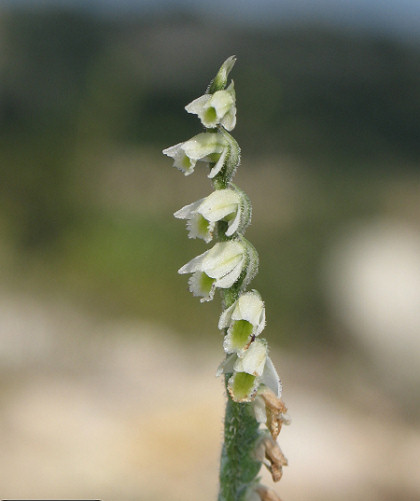
Spiranthes spiralis (ORCHIDACEAE.)
Images for this profile are taken from the Maltese Islands after year 2000. |
|
| Nomenclature |
Species name : | Spiranthes spiralis Chevall. | Authority : | Carl von Linne, Sweden, (1707 - 1778) ;
Francois Fulgis Chevallier, France, (1796 - 1840) | Synonyms :
(basionym or principal syn.) |
|
Plant Family : | | English name(s) : | Autumn Lady's Tresses | Maltese name(s) : | Ħajja u mejta tal-ħarifa | Status for Malta : | Indigenous. Present on the Maltese islands before man | Name Derivation : |
Spiranthes: from speira meaning spiral, and anthos for flower, referring to spiral arrangement of the flowers along the flowering spike. (Greek origin ); 2 = from the Greek "speira" = spiral, and "anthos" = flower, referring to the coiled or spiral character of the inflorescence, and hence the common name "ladies tresses" (Greek);.
spiralis: spiral arrangement (referring to the flowers). (Latin origin ); 2 = Spirally (Latin).
| Remarks : | |
|
| Morphology and structure |
PLANT STRUCTURE: |
Character | Growth Form | Branching | Surface |
Description | | | |
General
Picture |  | 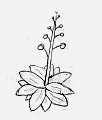 | 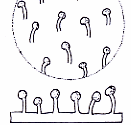 |
|
LEAVES: |
Character | Arrangement | Attachment | Venation |
Description | | | |
General
Picture | 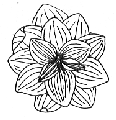 | 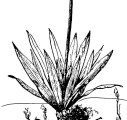 |  |
| |
Character | Leaf Shape | Leaf Margin | Remarks |
Description | | | |
General
Picture |  |  |  |
|
FLOWERS: |
Character | Colour | Basic Flower Type | No. of Petals | No. of Sepals |
Description | White and pale green The tepals are wax-white but the labellum has a pale green centre. | | 3 2 small and lateral, 1 central and slightly modified; referred to as the labellum. | 3 Identical and overlap on each other. |
General
Picture | |  |  |  |
| |
Character | Inflorescence | Description | Ovary | Stamens |
Description | | Flower consists of 3 white outer segments (= sepals) and 3 inner segments (= petals) of which 2 are small and the other is a modified, lip-shaped petal called labellum. The labellum is wax-white with a pale green centre and has a lacerated margin. | | |
General
Picture |  |  | 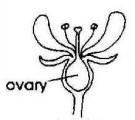 | 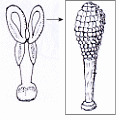 |
| |
Character | Scent | Average Flower Size | Pollen Colour | Other Notes |
Description | YES Sweet scent particularly in the evening. | 7mm x 4mm x 5mm (Length x Breadth x Depth including sepals). Length of labellum is about 4mm. Sizes vary by few mm in flowers of different specimens. | Yellow | - |
|
SEEDS: |
Character | No. Per Fruit | Shape | Size | Colour |
Description | > 2,000 Despite the large amounts, propagation by seeds is not much viable for Orchids . | Powder form (very small to have a distinct shape ). | Extremely small (powder form). | Cream |
General
Picture |  |  |  |  |
|
FRUIT AND OTHER BOTANICAL DATA: |
Character | Fruit Type | Colour of Fruit | Subterranean Parts | Other Notes |
Description | | Green | | Germination and Growth The germination and growth of the plant is successful only with the presence of specific microrhizzial funghi in the soil. |
General
Picture |  |  | 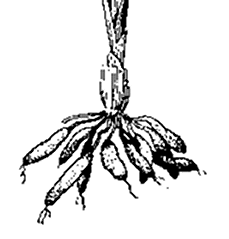 |  |
|
|
| Plant description and characters | |
Life Cycle: | Perennial. |
Growth Form: | GEOPHYTE (bearing underground bulbs, rhizomes, stolons, etc.) |
Habitat: | Low garigue, steppes, disturbed rocky ground, preferring exposed and arid areas. |
Frequency: | Rare |
Localities in Malta: | Ghar il-Kbir, Buskett, Dingli Cliffs. |
Plant Height: | 8-18cm. |
| Oct-Nov |
Protection in Malta: | Protected by law: Schedule VI of [S.L. 549.44] (strictly protected species) |
Red List 1989: | Threatened status for the Maltese Islands and has been listed in the Red Data Book (1st ed.) |
Poison: | |
Spiranthes spiralis is the first Orchid in Malta to flower in early Autumn after the first rains following the dry Summer months. The plant forms a basal rosette of slightly glossy, dark green leaves, not longer from 35mm, having an oval shape with a pointed tip, an entire margin and parallel veins. Unlike many Orchids, the flowering stalk is not found growing directly through the centre of the basal rosette but somewhere at their side.
The cauline (younger) leaves do not form part of the rosette but becomes erect and tightly wrapped around the flowering stalk (scape) that they look like large scales rather than leaves. The scape and flower bracts are covered with glandular, short hair, especially at its upper part.
The inflorescence is made up of 10-22 sessile flowers that are arranged in a characteristic spiral fashion. The spiral arrangement can be up to 3 full turns in specimen with long spikes.
Each flower have a hood-shaped, rounded bract with a white border and a conspicuous pointed tip. The bract covers the ovary but not the perianth segments. The perianth, which is wax-white in colour (semi-translucent), consists of 3 outer segments (=sepals) arranged as an inverted T-shape and 3 inner ones (=petals) arranged as a Y-shape. The upper central sepal and the 2 upper petals are fused to form a singular, tube-like structure in conjunction with the labellum (lower petal) which have up-curved edges. The 2 lateral sepals are sometimes spread out, ore more often curved partly inwards towards the other perianth segments, but never fused with them. The labellum has wax-white colour with a central, pale green throat. It has an interesting lacerated or fringed margin. A green, nectar-secreting groove is located down the centre of the lip. Fragrant smell is produced mostly during the evenings which vanishes during the day.
The reproductive organs are small (3-4mm) and mostly hidden by the perianth segments. The male organs basically consist of a pair of pollinia without caudicles, while the female organ is a small ovary with a partly ciliated stigma. The fertilized ovary swells into a 6mm long capsule which dehisce later in November releasing several thousands of microscopic powder-like seeds.
|
|
| Information, uses and other details |
Nativity and distribution
The distributional range of this plant is mostly in Europe as shown in the list below: [WWW-155]
Albania, Germany, Ex-USSR, Austria, Belgium, Bosnia-Herzgovina, Bulgaria, Danemark, Spain, France, Gibraltar, Grece, Hungary, Italy, Liechtenstein, Malta, Netherlands, Poland, Portugal, Roumania, Great Britain, North Ireland, Russia, Serbia & Montenegro, Slovakia, Sweden, Switzerland, Chzeck, Turkey
According to [WWW-60] the area of distribution is from the Mediterranean zone of Northern Europe to the Western Himalayas.
[WWW-141] also states that it is found in Sweden and south through all of Europe including Great Britain and the Ukraine but also include countries like Turkey, Syria, Lebanon and Western North Africa where the plant is found as a miniature.
Notes about the Genus
Spiranthes, commonly called Ladies' tresses, is a genus of orchids (family (Orchidaceae) belonging to the subfamily Orchidoideae.
It has a very wide, almost continuous distribution, mostly in temperate zones of the northern hemisphere : Europe, North Africa, Asia, Australia, New Guinea, the Americas and the Caribbean. They grow in meadows, fields and savannas but are also found in forests, both on acid and calcareous soil. Most species tend to become weeds in disturbed areas, while they may be scarce in undisturbed areas. [WWW-60]
Spiranthes consists of perennial, terrestrial orchids with clustered, tuberous or rarely fibrous, fleshy roots. The leaves are basal or occasionally cauline (i.e. emerging from the stem). They are variable in shape. They range from broadly ovate to elliptic, or absent at flowering. [WWW-60]
The flowering stem has foliaceous sheaths. The stem is erect and spiraling (as the name Spiranthes indicates). It carries persistent, sheathing bracts. The resupinate, tubular flowers are arranged in a more or less spirally twisted, showy or inconspicuous terminal spike. Their color is typically a shade of white or yellowish-white or even pink ( as in Spiranthes sinensis). [WWW-60]
This genus has undergone many taxonomic changes : originally Spiranthes contained all the species from the subtribe Spiranthinae. In 1920 Schlechter divided this genus in 24 genera. A revision by Williams in 1951 and by Schweinfurth in 1958, inflated the number of species of this genus again. Finally D. Szlachetko, with several studies in the 1990s, divided this genus in several genera, contained in 3 subtribes. During all these changes, there is only one species that has remained taxonomically unchanged : Spiranthes parksii. [WWW-60]
The genus Spiranthes (Orpet 1914), is characterized as "hardy native, easily transplated, flowering biennially, late summer and early autumn." Bailey (1914) concludes that "few species have any value; some of the hardy species are advertised by dealers of the native plants and by collectors." The name Spiranthes derives from Greek and refers to the twisted (spiral) spikes (Bailey 1914), hence the common name "Ladies' Tresses." The scape and inflorescence are attractive and suggest uses as a bedding plant, pot plant, or cut flower (Fig. 1). [WWW-114]
Cultivation Details
The growing season is determined by the start of the rainy season, and the dormancy of the bud located upon a short, underground shoot. The dormancy period usually begins in the second half of October and lasts until May or June. [WWW-114]
Trimmed bare root plants in the flower bud stage or with 30% of flowers opened can be air dried for 3 days, and then successfully transplanted. At the beginning of the growing season when plants were transplanted at the rosette stage (5-6 leaves) only one out of 108 plants was lost; when transplanted at the flowering stage bare root all 50 plants survived. [WWW-114]
Plants grown in pots, flowered yearly for three years. The plant diameter at flowering stage ranges from 20-30 cm. The scape is covered with several bracts, being longer at their base. The inflorescence is a spike whose dimensions vary with the soil, water conditions, and solar radiation. [WWW-114]
The plant can be grown in mass in parks, gardens, and urban areas in beds or pots. The medium height flowering scapes have orange flowers that turn to coffee-black starting at the base of the spike. Although this is a disadvantage for cut flowers, in group plantings the black flowers provide a contrast to the upper orange flowers which is attractive. At the end of the growing season the dead, above ground parts, should be trimmed. [WWW-114]
The stems are resistant to winds. Both the "bud," and the open flower are attractive in color and form. The inflorescence, slowly opens from the base to the apex but its esthetic value is lost when more than 70-75% of the spike is opened. The remains of the flowers do not abscise but remain attached to the spike. Low scape height for group planting and, for use as a pot plant would be desired. A low scape genotype has been found and is currently under observation. [WWW-114]
The stem can be used as a cut flower and for arrangements. The stem should be cut above the third leaf. The individual flowers opened continually. The stems held in water, without preservative, in a room of northern exposition (19°C day, 16°C night), lasted 10-14 days. Inflorescences wilted, after the stem was cut at noon, in full sun, but regained normal rigidity easily when the stem was placed in water within an hour. However, the inflorescence bent if the time from cutting to placing in a vase exceeded 1 hour. [WWW-114]
This plant prefers a wet soil at pH of 7 and full sun. For this plant the suggested fertilizer program would be based upon a typical mix of: 3 parts Nitrogen (N), 2 parts Phosphorous (P) and 3 parts Potassium (K for Latin name Kalium). [WWW-172]
Orchids are, in general, shallow-rooting plants of well-drained low-fertility soils. Their symbiotic relationship with a fungus in the soil allows them to obtain sufficient nutrients and be able to compete successfully with other plants. They are very sensitive to the addition of fertilizers or fungicides since these can harm the symbiotic fungus and thus kill the orchid [230].
This species is one of the commonest orchids in Britain, though it is often overlooked because it flowers so late. It sometimes naturalizes in lawns, especially where these overly a chalk substrate or a turf from chalky land has been used to make the lawn [230].
Many sources state that it likes calcareous, chalky or limestone-based soil [WWW-02, WWW-141, WWW-167, WWW-169]
Propagation Details
Seed - surface sow, preferably as soon as it is ripe, in the greenhouse and do not allow the compost to dry out. The seed of this species is extremely simple, it has a minute embryo surrounded by a single layer of protective cells. It contains very little food reserves and depends upon a symbiotic relationship with a species of soil-dwelling fungus. The fungal hyphae invade the seed and enter the cells of the embryo. The orchid soon begins to digest the fungal tissue and this acts as a food supply for the plant until it is able to obtain nutrients from decaying material in the soil [200]. It is best to use some of the soil that is growing around established plants in order to introduce the fungus, or to sow the seed around a plant of the same species and allow the seedlings to grow on until they are large enough to move. [WWW-02]
Division in autumn. Make sure that you keep plenty of soil with each plant. It is also said to be possible to transplant orchids after they have flowered but whilst they are still in leaf. [WWW-02]
Notes on Growth
After successful pollination, fertilization and seed formation, it can take 11 years from seed for the first leaves to be formed and several more years for the plant to reach flowering maturity. Plants grown under laboratory conditions have produced flowers in five years. [WWW-169] After flowering, it can persist for years underground, before emerging to flower again. It can remain for years in a non-flowering state, appearing in thousands if a site is left unmown (or undisturbed). [WWW-167, WWW-169] Overgrazing by sheep, and especially by rabbits, can also be a problem. [WWW-169]
Spiranthes spiralis is a long-lived orchid species; individuals may live more than 50 yr. The first rosette appears about 11 yr after seed germination and the first flowering stalk 2-4 yr later. Individual plants consist of rosettes and one or more small underground tubers that may live for several
decades. New tubers are formed during the winter and spring. The rosette leaves emerge in autumn and die off in late spring or early summer. [382]
Medicinal Uses
The plant has the following medicinal properties according to reference: [WWW-02, WWW-66].
| Aphrodisiac |
A drug or other agent that stimulates sexual desire. [WWW-32] |
| Homeopathic |
A term used in medicine when small doses of a drug cure symptoms like those that larger doses would cause [271] |
| Depurative |
An agent which is able of Purifying the blood or the humors (body fluids) [WWW-32] |
| Eye treatment |
Used agaisnt eye irritations and complaints. |
| Tonic |
A medicine that strengthens and invigorates hence restores normal tone to tissues or to stimulate the appetite. [WWW-32] |
A tincture of the root is used in homeopathy for skin affections, painful breasts, pain in the kidneys and eye complaints. Spiranthes diuretica was used in Chile in cases of ischury. [WWW-03]
The tuberous root has been used as an aphrodisiac [4]. A tincture of the root is used as a homeopathic remedy [4]. It is used in the treatment of skin affections, painful breasts, pain in the kidneys and eye complaints [4].
Pollination
There were found quite contrasting versions about the pollinators of this plant. In references [WWW-167, WWW-168] it was stated that the tiny flowers are pollinated by aphids (greenflies). On the other hand [WWW-169], states that at least two bumblebee species are involved in pollination, and seed-set is good.
This was similarly found source [320] and in a german website [WWW-170] which translates to:
The bloom time extends from approximately at the beginning of of August to at the end of of Septembers. The blooms are dusted by Hummeln (a type of bumble bee), which visit the spiral bloom conditions from bottom to top. The fruit lug is high. The autumn Drehwurz has a European spreading with radiant emittance to small Asia and the Caucasus. *
In another German website [WWW-171], the following text was given:
"Pollination: The blooms are dusted mainly by wasps (rarely of Hummeln or floating flies), which find the nectar attractive in the Hinterlippe v.a. if this begins to ferment in warm weather. Then one can observe more frequently "volltrunkene" wasps, which fall even from the blooms and carry partial numerous "pole lines" on the head. "
Spiranthes spiralis does not attract hummingbirds, sunbird or nectar feeding varieties of garden birds
It is not known as a butterfly attracting plant either. [WWW-172]
* (translated by an online translators, and hence text is not perfectly translated)
Flowering Frequency and Plant Performance and their Relation to Age in the Perennial Orchid Spiranthes spiralis (L.) Chevall.
Long-term demographic data have been analyzed to establish possible costs of flowering in the terrestrial orchid Spiranthes spiralis (L.) Chevall. in The Netherlands. [380]
Costs of flowering can be expressed as individual plant performance and flowering frequency in relation to the generative or vegetative status in the following year. Flowering in individuals of S. spiralis in a given year (t) is followed by a non-flowering phase in the next growing season (t + 1) in more than 80 % of the plants. The decline in flowering frequency is not a result of the age structure of the population involved because individual plants do not show signs of senescence after 10 - 15 years of aerial presence as an autotrophic plant. Rosettes have a smaller leaf area in the year of flowering (t), compared to the previous (t - 1) and following year (t + 1), due to the allocation of the limited underground resources to both flowering stalk and rosette at the beginning of its growing season. Generative reproduction in S. spiralis has a significant negative impact on both flowering frequency in subsequent years and on rosette size in the year of flowering. [380]
The flowering frequency and rosette size in relation to the life history, characterized by the yearly replacement of the underground tuber, is discussed. Better understanding of the life-history strategy, including costs of reproduction, may contribute to the creation of sustainable environmental conditions for growth of S. spiralis, e.g., optimal conditions for photosynthesis during the aboveground stage of the tiny wintergreen rosettes. [380]
Changes in a Population of Spiranthes Spiralis (L.) Chevall. at Knocking Hoe National Nature Reserve, Bedfordshire, 1962-65
1. Observations were made from 1962 to 1965 on the reproductive behaviour of a population of Spiranthes spiralis growing in chalk downland at Knocking Hoe, Bedfordshire. Individual plants were recorded each year by reference to fixed markers. The condition of each plant, whether vegetative or flowering, was ascertained and the height of each inflorescence and the number of flowers per plant measured; their variation is described in relation to environmental factors. [381]
2. There was no evidence to support the view that large fluctuations in numbers of plants or inflorescence production occurred from year to year. [381]
3. The diverse reproductive behaviour in 1964 and 1965 of the 463 plants which flowered in 1963 suggested that flowering was not controlled by a single climatic factor. On the contrary, the data suggested that flower production was controlled by a complex of factors, in which the activities of mycorrhiza were of importance. [381]
4. The orchid was able to pass at least a year and possibly more as an underground tuber with no leaves. It was capable of flowering the following year, which suggested that mycorrhiza played an important part in the nutrition of the plant. The ability to remain as an underground organ for at least a year may be significant for survival of the plant in unfavourable seasons. [381]
5. Increase in the population by vegetative reproduction was slow, about 5% of the plants producing a new plant in this way in one year. [381]
6. The number of flowers per inflorescence varied from three to twenty-one with mean values of 10.9, 10.1 and 11.3 for the whole population in 1963, 1964 and 1965 respectively. These differences were not statistically significant. [381]
7. The length of the inflorescence varied from 4.5 to 19 cm but plants at the two extremes were rare. The mean height of the inflorescences in 1965 was 10.50 cm, compared with a mean height of 8.86 cm in 1964. This difference was significant at the 5% level of probability and the increase in height may be associated with the higher summer rainfall of 1965. [381]
8. The basal rosette of leaves was not eaten by herbivores. Grazing by sheep at a density of 10 per hectare resulted in 30% of the inflorescences being damaged but at lower stocking densities grazing by herbivores, including rabbits, caused less damage. [381]
Scent
In the evening the flowers diffuse a penetrating almond-like perfume, similar to heliotrope [245]. A fragile scent can be sometimes detected during early mornings, but it fades away completely by late morning onwards, especially on windy days. [SM]
Personal Observations
Leaves and flowering stalk.
In several sources, such as [WWW-169, WWW-167 and WWW-141] it is stated that a flat rosette of 4-5 leaves are formed in late autumn and these wither before the flower spike emerges, so that there are no leaves at the base of the current flower spike. In all 10-12 specimen seen in Malta, they had a basal rosette with an ecentric flowering spike next to them. Hence in Malta, the leaves and scape can be seen together unlike the growth habit of northern countries. In all sources, the flowering time is Autumn (fall). [SM]
Flower Browning
The flowers have a delicate, semi-translucent (sometimes referred as wax-white or snow-white) perianth segments, which are rather delicate. The thinner margins are supscetible to turn brown by wind abrasion or perhaps by hot sunshine (quite common in October in Malta) on dew or moisture gathered on the perianth segments. The exposed labellum is the most affected, since the other tepals are somehow folded and protected on each other.
|
|
| Links & Further literature
(0 papers) |

Google Web |

Google Images |

Google Scholar |

Research Gate |

Wikipedia |

JSTOR |

GBIF |

Med Checklist |

Cat. of Life |

EoL |

IPNI |

World Flora Online |

Plants of the World Online |

Vienna Virt. Herb. |

RBGE Herbarium |

KEW Herbarium |

MNHN |

Arkive |

IUCN |

CABI |
Kindly Email if there are papers and publications about local
studies or information about this species to be included in the list above.
|
| Photo Gallery (28 Images) |  |
 |
 |
 |
IMAGE: SPISP-01 Photo of the flowering spike which consists of sessile flowers in a spiral arrangement. |
IMAGE: SPISP-02 Photo of flowers found at the uppermost part of spiral flowering spike. |
IMAGE: SPISP-03 Photo of the inflorescence in situ. The plant can have up to 20 flowers. |
IMAGE: SPISP-04 Photo of the spirally arranged flower spike. |
 |
 |
 |
 |
IMAGE: SPISP-05 Photo of 2 flowering spikes with the Verdala Palace (Buskett) at the background. The spiral arrangement is in an anti-clockwise way. |
IMAGE: SPISP-06 Photo of individual flowers which have a small perianth, about 6-7mm long. The bracts and stem are covered by glandular hair. |
IMAGE: SPISP-07 Photo of flowers at the uppermost part of the spike. The perianth segments are white with the labellum having a pale green colour at its centre. |
IMAGE: SPISP-08 Photo of the flowers of this Autumn-flowering Orchid. The tepals are not patent (spread out) but instead they form a perianth with a rather tubular structure. |
 |
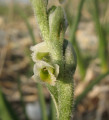 |
 |
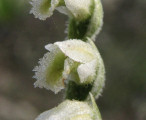 |
IMAGE: SPISP-09 Close up photo of the flowers. Sometimes the margins of the perianth segments are brown due to the effects of wind. |
IMAGE: SPISP-10 Close up photo of some flowers which, as it can be seen in this photo, they are themselves wound around the flowering stalk. |
IMAGE: SPISP-11 Close up photo of flowers. The lower and largest perianth segment - the labellum - has its edges re-curved up with a prominent lacerated (=as if torn up) outline. |
IMAGE: SPISP-12 Close up photo of a flower showing the detail of the labellum. This photo, taken against a dark background, demonstrates the semi-translucent colour of the tepals and so, the colour is sometimes referred to as wax-white. Central part of labellum is pale green. |
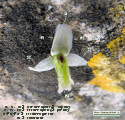 |
 |
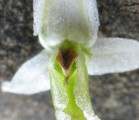 |
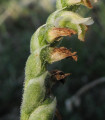 |
IMAGE: SPISP-13 Photo of a flower removed from scape and with some tepals bent out to show better the flower's morphological features. Details about the tepals are annotated on the photo itself. Note that in this species the upper 3 tepals (2 petals + 1 sepal) are fused together. |
IMAGE: SPISP-14 Close up photo of labellum and the flower's reproductive organs. There is a pair of inconspicuous pollinia (male organs) that lack caudicles. |
IMAGE: SPISP-15 Close up photo of the reproductive organs where both male and female organs are close to each other in a common structure. |
IMAGE: SPISP-16 Photo of the bracts - curved, hood-shaped structures that cover completely the ovary, but not the perianth segments. They are hairy and have a white border. |
 |
 |
 |
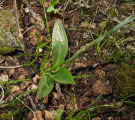 |
IMAGE: SPISP-17 Side-view photo of bracts showing their hood-like structure with a conspicuous pointed tip. |
IMAGE: SPISP-18 Photo of a young developing fruit capsule. |
IMAGE: SPISP-19 Photo of fruit in situ. They are ovoid structures which split open longitudinally when ripe, releasing thousands of tiny seeds. |
IMAGE: SPISP-20 Photo of the leaves found as a basal rosette. They are lanceolate with a pointed tip. |
 |
 |
 |
 |
IMAGE: SPISP-21 Photo of the leaves and part of the scape (flowering stalk). Interestingly, the flower stalk does not grow through the centre of the leaves as in many other orchid species, but is is found somewhere at the side. |
IMAGE: SPISP-22 Photo of the upper leaves (cauline leaves) which are found tightly wrapped around the flowering stalk and overlap each other. 2 cauline leaves are shown in this photo. |
IMAGE: SPISP-23 Photo of the cauline leaves tightly sheathing the scape. |
IMAGE: SPISP-24 Photo of the spiral inflorescence, a characteristic morphological feature of this Orchid. |
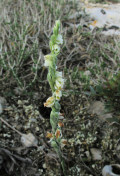 |
 |
 |
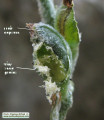 |
IMAGE: SPISP-25 Photo of the spiral inflorescence which can have a maximum of 3 anticlockwise turns, as seen in this photo. |
IMAGE: SPISP-26 Photo of a plant situated in a rocky wasteground. |
IMAGE: SPISP-27 Photo of 2 plants close to each other. |
IMAGE: SPISP-28 Photo of a fruit capsule which was found burst open with many white, tiny, grain-like seeds escaping out. It is not sure if the fruit had split open because it was ripe or if by some physical damage. |
|
| | |

